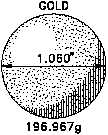Fundamentals of Chemistry
DOE-HDBK-1015/1-93
CHARACTERISTICS OF ATOMS
Rev. 0
CH-01
Page 9
Figure 2 A Mole of Gold Compared to a
Mole of Copper
Because the sulfur atom weighs twice as much as an oxygen atom, a one gram sample of oxygen
contains twice as many atoms as a one gram sample of sulfur. Thus, a two gram sample of sulfur
contains the same number of atoms as a one gram sample of oxygen.
From this previous example, one might suggest that a relationship exists between the weight of
a sample and the number of atoms in the sample. In fact, scientists have determined that there
is a definite relationship between the number of atoms in a sample and the sample's weight.
Experimentation has shown that, for any element, a sample containing the atomic weight in
grams contains 6.022 x 10 atoms. Thus 15.999 grams of oxygen contains 6.022 x 10 atoms,
23
23
and 32.06 grams of sulfur contains 6.022 x 10 atoms. This number (6.022 x 10 ) is known
23
23
as Avogadro's number. The importance of Avogadro's number to chemistry should be clear.
It represents the number of atoms in X grams of any element, where X is the atomic weight of
the element. It permits chemists to predict and use exact amounts of elements needed to cause
desired chemical reactions to occur.
The Mole
A single atom or a few atoms are rarely encountered. Instead, larger, macroscopic quantities
are used to quantify or measure collections of atoms or molecules, such as a glass of water, a
gallon of alcohol, or two aspirin. Chemists have introduced a large unit of matter, the mole, to
deal with macroscopic samples of matter.
One mole represents a definite number of objects, substances, or particles. (For example, a mole
of atoms, a mole of ions, a mole of molecules, and even, theoretically, a mole of elephants.) A
mole is defined as the quantity of a pure substance that contains 6.022 x 10 units (atoms, ions,
23
molecules, or elephants) of that substance. In other words, a mole is Avogadro's number of
anything.
For any element, the mass of a mole of that element's
atoms is the atomic mass expressed in units of grams.
For example, to calculate the mass of a mole of
copper atoms, simply express the atomic mass of
copper in units of grams. Because the atomic mass of
copper is 63.546 amu, a mole of copper has a mass of
63.546 grams. The value for the atomic mass of gold
is 196.967 amu. Therefore, a mole of gold has a mass
of 196.967 grams. The mass of a mole of atoms is
called the gram atomic weight (GAW). The mole
concept allows the conversion of grams of a substance
to moles and vice versa.
Figure 2 contains a ball of gold and a ball of copper.
The two balls are of different masses and different
sizes, but each contains an identical number of atoms.



